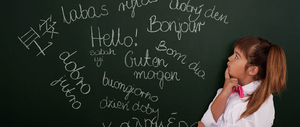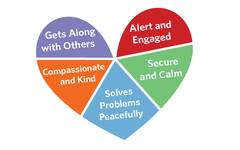Learning a Language and its Culture in a Mindful Manner

Just under ten months ago, I packed my bags in Toronto and made the big move across the country to Vancouver to start the Bachelors of Education program at UBC. Having studied French and English for over six years I felt I knew a lot and was well versed in the languages I would soon be teaching, but I knew very little of Social Emotional Learning (SEL) and Heart-Mind Well-Being. Excited and eager to start the program, all UBC teacher candidates undertook classes such as classroom support and inquiry, and quickly became familiar with the transition happening in BC to the new curriculum. But the true test for us all came in February when teacher candidates started their practicum at secondary schools throughout the province. We were to apply everything that we had learned from the education program at UBC in our very own (temporary) classrooms.
Arriving at my practicum school that first day, I remember feeling truly amazed by the students and thinking to myself that one of the benefits to teaching today, specifically in Canada, is the great diversity that exists within this country and as an extension, in the classroom. At the secondary level, studying French and English is not only focused on vocabulary and grammar but also on literature, which is very much embedded in culture and history. Although I would introduce myself to you as a French and English teacher I am actually passionate about all languages, cultures and people, even though I am only able to speak two. There is a quote by an American writer Rita Mae Brown that I think describes the beautiful connection between languages and humankind, “Language is the roadmap of a culture. It tells you where its people came from and where they are going.”
As a language e nthusiast, after meeting my students during practicum, I immediately asked myself how I could incorporate multiple languages and cultures through the teaching of just one language. How could I provide students with the tools to communicate in French, thinking about various cultures (including French culture) while making connections to their own personal culture and identity, and simultaneously draw comparisons to their social community (i.e. their peers)? This question is one that brings us back to the three core competencies of the new BC curriculum, which are communication, thinking, personal & social. It is my belief that we can take this question one step further by asking ourselves how can we communicate (in this case, in another language), think about and understand the concepts/information learnt and relate to them in a personal and social way, but also most importantly in a mindful manner within our classroom community? Now, you might be wondering, what exactly do I mean by “mindful manner”? This component is one that I came to identify with and recognize after my Community Field Experience (CFE) at the Dalai Lama Center for Peace and Education, where I learnt the power and importance behind Heart-Mind Well-Being.
nthusiast, after meeting my students during practicum, I immediately asked myself how I could incorporate multiple languages and cultures through the teaching of just one language. How could I provide students with the tools to communicate in French, thinking about various cultures (including French culture) while making connections to their own personal culture and identity, and simultaneously draw comparisons to their social community (i.e. their peers)? This question is one that brings us back to the three core competencies of the new BC curriculum, which are communication, thinking, personal & social. It is my belief that we can take this question one step further by asking ourselves how can we communicate (in this case, in another language), think about and understand the concepts/information learnt and relate to them in a personal and social way, but also most importantly in a mindful manner within our classroom community? Now, you might be wondering, what exactly do I mean by “mindful manner”? This component is one that I came to identify with and recognize after my Community Field Experience (CFE) at the Dalai Lama Center for Peace and Education, where I learnt the power and importance behind Heart-Mind Well-Being.
Here are a few ways that I approached this question during my practicum teaching Grades 8-12 French and English along with details to specific activities I incorporated in my classroom.
1. Encourage and insist that students become stakeholders in their own education.
a) Grade: 12 Core French (IB), Unit: The Environment
The class was organized into groups and each group was given a newspaper article in French about an environmental invention/solution created in different countries. For instance one Canadian invention was Vitality Air, one French invention was Hydrao, another invention by Australians was Seabin, etc. Each group studied the invention assigned to them, discussing the pros and cons, long and short-term impacts, personal opinion, and the relevancy to our community today. After completing their analysis of the invention in groups they rotated around the class to other groups explaining the invention in French as well as their opinions as a group. By teaching one another, each student became responsible not only for their own education but also that of their peers.
b) Grade: 11 English (IB), Unit: The Handmaid’s Tale by Margaret Atwood
Part way though the novel; the class completed a Wiki Notes project. In pairs, students were assigned characters, settings, themes and symbols we had encountered thus far in the novel. Each pair was responsible for creating their own one-page wiki notes handout with heading such as: summary, important quotes, significance, illustration, links to previous novels studied and links to our society today. Students were given class time to work on this project and within the next few days they were to present to the class their wiki notes and provide me with the handout so that I could make a photocopy of each handout for every student in the class. This project proved to be extremely beneficial as students were able to continuously add to these notes through the novel. As a result of this project the class formed a literary community within the classroom, relying on each other’s thoughts, opinions and interpretations. [Picture of project]
2. Have students practice being effective, constructive and gentle communicators.
a) Grade: 10 English, Unit: Poetry
The final project of this unit was for each student to submit a poetry portfolio consisting of reader responses, illustrations to poems, a selection of poems (not studied in class) and their own poems. However, before submitting their portfolios we had a peer revision class were each student brought their final project to class to be reviewed by their classmates. Each student was provided with three evaluation forms and were responsible for editing three classmates’ portfolios, thus by the end of class each student had three forms of feedback on their project. Of course before commencing the peer revision process a quick lesson on how to provide constructive feedback is beneficial. Students then had a couple of days to alter their portfolios from the advice their peers gave them. The day the portfolio was due; the class was arranged in groups of 4-5 students where each student shared a part of their portfolio (whether it be a poem they wrote, or an illustration, etc). This process showed students the value behind giving and receiving constructive feedback from peers and how to communicate in a gentle manner.
b) Grade: 9 French, Unit: Retro-Monde (the 60s, 70s and 80s)
One section of this unit was on dance moves from the previous decades. Students picked classmates’ names out of a hat to form groups of two to three. The class was then provided with a list of popular dance moves from the 60s, 70s, 80s and today. They were responsible for learning the dance, explaining it in an instructional format (step by step) in French and finding a song to accompany the dance. While some groups picked the twist or the Macarena, others asked if they could present a K-pop dance, which I enthusiastically agreed to. In order to explain the dance in instructional steps student had to use grammar concepts that we learnt in class, and I did a demo presentation of the Macarena in French so that students were aware of what was expected. The day of the presentations all desks were moved aside, and we formed a circle around the classroom with the presenters at the front. Everyone had to participate in the dance, which was key for this activity to work. Even I joined in! The groups were to present their dance step by step showing us the moves while we mimicked them, we then went through the steps once more and finally one last time with the music was turned on so we could do it together with the presenters leading us. This activity may have more non-verbal communication than verbal, however the explanation, set-up and participation (from the presenters, students, and myself) are a crucial part to foster gentle communicators.
These are just a few examples of how I approached my initial question in regards to the core competences from a language arts point of view, adhering to the new BC curriculum through the lens of Heart-Mind Well-Being framework developed by the Dalai Lama Center for Peace and Education. It is my hope that, as I continue my studies in the education program and grow as an educator, I can develop more and more activities that incorporate communication, thinking, personal and social aspects through the lens of the Heart-Mind Well-Being framework.
by Nadia Valani







Comments
Post new comment